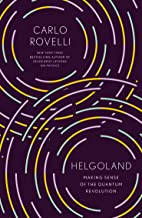Helgoland by Carlo Rovelli 2021
Rovelli is a superb writer—lucid, engaging, clever metaphors, wonderful examples—but despite all of that, the ability to explain quantum theory continues to elude me. Like the photon or electron which can not be both placed in space and have its speed measured at the same time, I can read the words, take down my notes and quotations, and then be nearly completely befuddled when I try to explain the material to my patient and long-suffering wife.
Suffice it to say that this is the best in a long line of books that I’ve read in recent years to help me understand how the classical physics of Newton’s mechanical universe that I learned in high school and college has morphed into the modern quantum physics of Einstein’s relativity, Heisenberg’s Uncertainty Principle, Planck’s constant, etc. Rovelli does a terrific job of explaining how what we call a chair which has mass, location in space, and functional aspects is really just the result of the myopia of our macroscopic vision. Were we to be able to look clearly and very, very, very closely, we would realize that the chair is composed of quanta each of which is a probabalistic function of its relationship to other quanta and to me the observer. Information, relevant and relative, is the key to this quantum world.
Here’s the way he summarizes the situation: “A single equation codes quantum theory. It implies that the world is not continuous but granular. There is no infinite in going toward the small: things cannot get infinitely smaller. It tells us that the future is not determined by the present. It tells us that physical things have properties only in relation to other physical things, and that these properties make sense ony hen things interact. It tells us that sometimes perspectives cannot be juxtaposed. In our everyday life, we are not aware of any of this.”
In addition to the clearest exposition of quantum theory, Rovelli delves into the issue of brain/mind and consciousness. He cites a modern philosopher David Chalmers who divides the problem of consciousness into two parts, ‘easy’ and ‘hard’. The easy questions are those about brain functioning, i.e. how does a 3 kg mass of stuff think, feel, plan, etc., and Rovelli is confident that those will be answered in due time. The hard questions are about how to explain the subjective feelings that accompany what the brain does. This is the question addressed in Metazoa and involves explorations in recently read books by Paul Nurse, Frank Wilzeck, and Brian Greene. Rovelli has no illusions that the beauty and reality of quantum theory will explain the hard question of how we are aware of our feelings and thoughts, but his exploration of our subjective minds makes for fascinating reading.
This is a special book, but not an easy one. Anyone interested in the fundamental structures of our world, cosmology, neuroscience, and science in general will find it worth the effort. I was initially drawn to it because I thought Helgoland was like Legoland, but it’s not. It’s an island in the North Sea, bleak and bereft of any spa-like features, but it was where Werner Heisenberg spent several months in 1925 and where he first deduced the wonders of quantum theory. It’s somewhat awesome to see where the nearly hundred years since then have brought us, and it’s beyond my comprehension to imagine where the next hundred years will take us. Too bad I won’t be around to be confused about that then.



